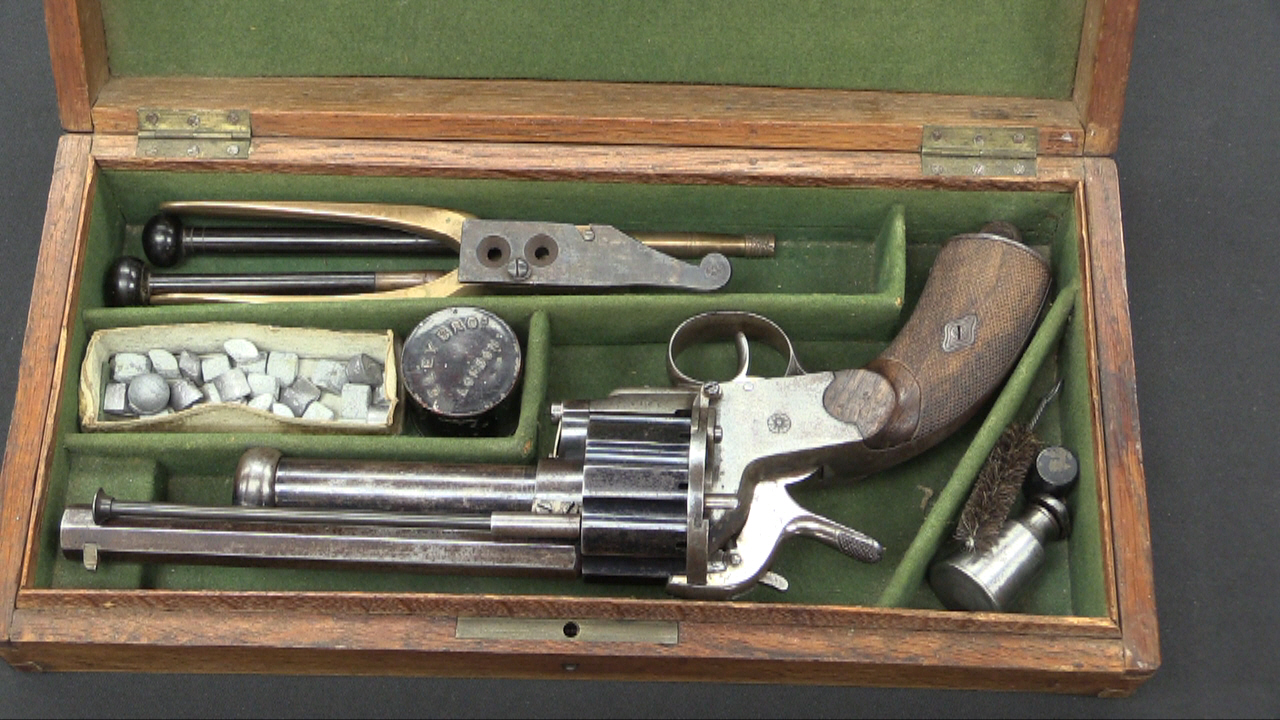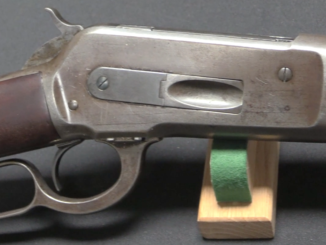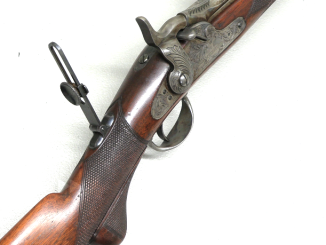These unique and unmarked prototype .32 ACP pistols are apparently Iver Johnson prototypes – and I can’t find any information on them beyond that description from their consignor. One is a simpler example in the white, and the other is a more developed example with both a manual safety and an unusual style of grip safety. If anyone has any further information on these, I would be interested to hear it!
Related Articles

Percussion
Pinfire LeMat Grapeshot Revolver at RIA
Colonel Jean Alexandre LeMat was a native Frenchman who emigrated to the United States and in 1856 secured a patent for a “grapeshot revolver”, which had both a 9-shot .42 caliber cylinder and a 20-gauge […]

Lever Action Rifles
Winchester Lever Action Development: Model 1886
Saddle Ring Carbine Deluxe Rifle The Model 1886 was the first Winchester repeating rifle to improve on the original toggle locking system of the 1860 Henry, and it is also the first of John Moses […]

Antiques
Model 1875 Officer’s Pattern: The Finest Trapdoor Springfield
As the main national armory, Springfield got a number of requests to make specialty rifles for commissioned officers and important dignitaries each year. These were essentially all custom sporting rifles, and the orders were duly […]

ON THIS SERIES OF WEAPONS YOU CAN GET FROM HI-TECH TO PRE-HISTORIC SLING WEAPONS SYSTEMS.
This looks like a sample of shaping things from 1950s – really elegant to point of impractical.
Speaking of impractical; how is shooter supposed to safely operate this thing while proximity of his index finger is so (damn) close to ejection port? Location of ejection port and direction on pistols generally is little bit tricky and way we have it now with ejection at 1-2 o’clock had not been always the case in past.
I see some resemblance in general-shape/proportions with Warner Arms Infallible automatic pistol, compare photos in given links to http://www.collectorsfirearms.com/warner-arms-infallible-32-acp-pr27340/
I thought this at first as well. The inventor of the Infallible pistols, Andrew Fyrberg, had worked for Iver Johnson in the past and patented designs for that company.
But, the patents for the Infallible pistols show a different internal operating system, specifically the recoil springs were back in the area of the slide or bolt rather than over the barrel:
US1105416
US1131360
So, I kept looking. And eventually found the patent for these pistols.
Here’s the patent for this pistol:
https://www.google.com/patents/US992854
Lyman H. Cobb — Filed 29 May 1909 — Published 23 May 1911
You’ll note that this is for the rough, prototype pistol. I wasn’t able to find a patent for the changes made for the more finished example. The patent describes a double-action-only, hammer fired pistol where the hammer follows the bolt down between shots. So, there is no need for a manual safety since the hammer is never in a full cock condition. I’m going to guess that this firearm would double, or go full auto. So, the more finished example probably has a more conventional single-action trigger with a full cock notch, thus the addition of a safety. It also appears to do away with the “wedge” holding the barrel to the frame, replacing it with a couple screws.
Lyman H. Cobb worked for the Iver Johnson company and has other patents assigned to that company. You’ll note that this patent is assigned to Mary Elizabeth Johnson, trustee. M. E. Johnson is identified as the “executrix” to Iver Johnson, (either the man or the company or both). So there’s the Iver Johnson connection.
Although visually interesting, this appears to be just another failed attempt to design a pistol around the constraints put on the industry by the various pistol patents by John M. Browning that were, at this time, still in force.
Thanks for the patent Brian. Your merit of finding related patents is fascinating.
Regarding to the possibility of firing full auto or doubling this kind of DAO triggers with no disconnector, if the backward bottom face of breechbolt made in approprite lenght, the impact of hammer follow remains at back, bottom corner of breechbolt without reaching the firing pin and causes no firing. There are pistols manufactured in this way, like CZ 45. IMHO.
Just to say I have really enjoyed this series of videos.entertaining and informative,thanks Ian
The shape of the grip and the relation of it to the trigger is closer to that of a revolver. Maybe it was designed by a revolver shooter, or by someone aiming at selling to people more used to shooting revolvers.
Agreed, as this grip seems optimal for the one-handed duelist pose. The problem with such a pose comes from the issue of “recoil damping” of one’s elbow (during firing) interfering with the reloading cycle of any semiautomatic pistol. Unless I’m totally wrong, attempting a quick draw with a loaded and cocked Browning action pistol and then rapidly firing from the hip Wild West style will increase the chances of either stove-piping or extraction failure…
“attempting a quick draw with a loaded and cocked Browning action pistol and then rapidly firing from the hip Wild West style will increase the chances of either stove-piping or extraction failure…”
Absolutely, and that’s one reason why the convention wisdom here in the US for perhaps most of the 20th century was that this intrinsic “limp-wristing” failure of semiauto pistols made revolvers a safer choice for self-defense use, since they could be fired from the hip with near-100% reliability. Ironically, the gun that ended up replacing the rock-solid revolver was the thermoplastic-framed “polymer” pistol, which due to the laws of physics had to be even less “hip-firing friendly” than the traditional heavy steel pistol.
I wonder if anyone has ever compiled measurements of various semiauto pistols (shooting various pressures and bulletweights of ammo) that determined the minimum recoil-resisting mass/force necessary to properly cycle the action when fired semi-to-fully “limp wristed”?
I’ve never seen any such chart, but I would hope that some testing laboratory somewhere has (or soon will) put one together. The same probably goes for semi-auto rifles and shotguns. It’s information that could be very helpful to prospective buyers — certainly better than the general “rules of thumb” that seems to be all anyone has to go by.
Good point, but half the problem is that hardly anyone will confess to ever having had a limp-wristed jam. Manufacturers can safely ignore the issue because no one will admit to having a problem with it. Who wants to admit to having a weak grip?
While hip shooting feel out of favor going on half a century ago, the current reality is that one may be injured, firing with the weak hand, or firing in an awkward position, and in any of those cases the less likely the pistol is to jam from limp-wristing the better. The gun fight that is talked about a lot, the infamous Miami shootout, had two of the good guys shot in either the arm or the hand, and the person who ultimately killed the bad guys did so shooting one handed (his other arm being badly wounded) and in a weakened state–he used a revolver. His S&W 586 went bang every time he pulled the trigger. The FBI just went to Glocks–wonder how that would have worked that day?
“While hip shooting feel out of favor going on half a century ago, the current reality is that one may be injured, firing with the weak hand, or firing in an awkward position, and in any of those cases the less likely the pistol is to jam from limp-wristing the better.”
I would think that the most justified situation calling for “hip firing” is when an attacker is only arms-length away and would naturally try to grab the gun the instant it entered his reach.
The old Speed Rock/Shooting from Retention police hip-firing techniques developed precisely for such up-close-and-personal fighting might not be taught/emphasized as much anymore, since the demise of the revolver presumably made them less reliable due to the semiauto’s limp-wristing issue.
“semiauto’s limp-wristing issue”
Isn’t that mean that ammunition used is simply too weak to cycle action?
Unless purposedly made, it is hardly impossible to get a malfunction throgh limp wristing with most of the current autoloaders. IMHO.
Unless you are using the infamous 147-gr. subsonic JHP 9 x 19mm, which was hastily dumped by most LEO that adopted it in the 1990s and early 2000s due to lack of expansion, overpenetration, and tendency to smokestack-jam almost any self-loader with anything less than a perfect address.
In one case I’m familiar with, a sheriff’s deputy engaged in a shootout with a deranged man in a gunshop (said DM had a .32 auto and wanted to “liberate” a pair of 9mm M92s for an Unruh-style “cleaning up enemies’ list” rampage) had his Glock 19 jam when his hold (being too high) caused the slide to drag on the top of his hand at the first shot.
Combined with the low recoil impulse of the 147-gr subsonic 9mm his department issued, his pistol smokestacked, taking him out of the fight until he cleared it.
The store clerk ended the engagement with two rounds of 10mm JHP from his Colt Delta Elite.
After the review, the sheriff’s department in question changed to Federal Hydra-Shok 124-gr. JHP, and has had no further occurrences of this type.
About the same time, the Columbus (OH) PD adopted the 9mm S&W M&P with 147-gr., while the surrounding Franklin Co. SO used the same pistol with 115-gr Federal 9BP JHP.
Not only did CPD note recurring jams on the range, they had several shootings with through-and-throughs due to lack of expansion, two of which ended in lawsuits by third parties against the city.
During the same period, with the same pistol but with the 115-gr JHP, FCSO had no such problems.
In the end, both LE standardized on 124-gr. Hydra-Shok. No problems since then.
Moral; it generally isn’t exclusively the shooter’s fault. Most times, it takes a combination of factors to cause a stoppage.
And ammunition is almost always a contributor.
cheers
eon
“same probably goes for semi-auto rifles and shotguns”
First you must answer one question: which semi-auto rifle or which shotgun?
I don’t see possibility to create fail with gas-operated self-loading rifle by gripping it weakly.
“First you must answer one question: which semi-auto rifle or which shotgun?”
I’d say that except for .22 rifles, most semi-autos need to be shouldered (or otherwise recoil-stabilized) to cycle reliably (provided of course that the self-loading mechanism is not already over-compensated, a common ‘feature’ on military-type rifles). Need a specific example — How about a Saiga-12?
The basic principle that governs the extraction side of self-loading firearms is that when fired, the (elastically-attached) bolt/slide recoils at a substantially higher velocity/acceleration than the (much heavier) body of the gun. This velocity-differential is magnified when the gun is braced against something that resists motion, as well as when firing a heavy load (which increases the bolt’s velocity much more than it increases the gun’s recoil velocity).
Any semiauto gun, even a very lightweight one, could of course be designed to extract the fired case while the gun is essentially “suspended in air” — but such design would mean that when fired properly (shouldered or fired w/locked arms) the bolt/slide would be slamming back excessively hard. So it’s a compromise between extraction reliability and comfortable shootability (&lifespan of the gun). I don’t know how the manufacturers of the latest super-ultralight plastic 9mm pocket pistols “tune” their guns, but I think I would prefer for such a dedicated self-defence gun to be optimized for airtight reliability at the expense of undue harshness.
“Unless purposedly made, it is hardly [im]possible to get a malfunction throgh limp wristing with most of the current autoloaders. IMHO.”
I’ve seen a few police dashcam videos on Youtube that show a cop’s service pistol (presumably a Glock) jamming in a struggle, either from limp-wristing or perhaps from having the slide grabbed. It goes without saying that such situations are the worst possible time to be trying to clear a jammed pistol.
Grabbing the slide does work, but limp-wristing to me seems a much more dubious way of causing malfunctions in a modern pistol. Is there any hard data available on the matter? Preferably with a mechanical setup that eliminates the human factor completely, because humans are not going to have their wrists limp in a predictable and consistent manner…
I have personally seen a Glock 17 limp wristed. 9mm factory ammo (not weak reloads). The owner of it was asking if I thought there was something wrong with the gun, then his instructor told him to hold it tighter and the problem went away. So yes it happens, especially with lower-mass pistols but I think few would admit to ever having the problem.
Personally, I think a hand gun is for when things are going badly and one more failure mode is not good. I would take a CZ75 over a Glock, but that is just my opinion.
They look like Kijiro Nambu decided to copy a Pieper.
This type of recoil spring over the barrel construction should be the most convenient lay out for autoloading pistols with minimum of width. It is nearly possible to design a handgun having the width of sole barrel through this approach and in descreet type of pistol design, it should be a big question why this concept been not revisited in novadays.
According to the patent, recoiling movement of breechbolt remains within the receiver giving no outward projection during firing and its eventual mass, by cause of the need of finding room in this very limited area, becomes small for inertial locking of breechbolt against to the recoil of used .32″ round and this would be of the cause of giving up its possible manufacturing.